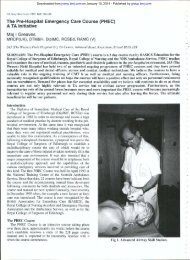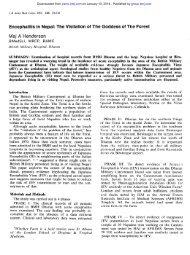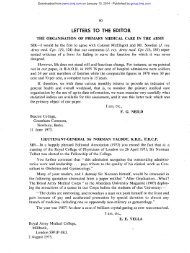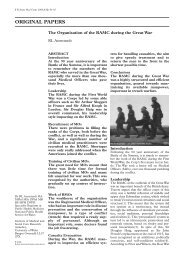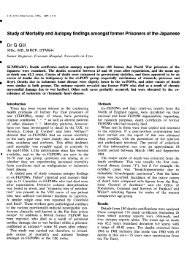Novel Haemostatic Dressings - Journal of the Royal Army Medical ...
Novel Haemostatic Dressings - Journal of the Royal Army Medical ...
Novel Haemostatic Dressings - Journal of the Royal Army Medical ...
You also want an ePaper? Increase the reach of your titles
YUMPU automatically turns print PDFs into web optimized ePapers that Google loves.
ei<strong>the</strong>r completely effective (5/7 animals) or ineffective, this was<br />
thought to be due to quality assurance issues [23]. These were<br />
addressed and <strong>the</strong> new dressings were tested at <strong>the</strong> USAISR<br />
“expeditiously (in one day)” [51] before being declared suitable for<br />
utilization in current <strong>the</strong>atres <strong>of</strong> operations.<br />
In 2008 HemCon ® was again examined in a swine femoral<br />
vasculature complete transection model. It performed no better<br />
than standard gauze with respect to mortality [52]. In this study<br />
HemCon ® was applied after 30 seconds <strong>of</strong> uncontrolled<br />
haemorrhage. Direct manual pressure was maintained for five<br />
minutes through an abdominal pack and <strong>the</strong> wound examined.<br />
Failure to achieve haemostasis was defined as “blood pooling<br />
outside <strong>the</strong> wound.” Aggressive fluid resuscitation commenced on<br />
application <strong>of</strong> <strong>the</strong> dressing, with lactated Ringer’s solution delivered<br />
at 165ml/min in an attempt to maintain mean arterial blood<br />
pressure (MABP) at pre-injury levels. During <strong>the</strong> 120-minute<br />
study period <strong>the</strong>re were 8/10 dressing failures in <strong>the</strong> HemCon ®<br />
group with three deaths. Standard gauze dressings resulted in 5/10<br />
dressing failures with one death.<br />
The significant differences between <strong>the</strong> Alam 2004 [23] and<br />
Englehart 2008 [52] studies were <strong>the</strong> duration <strong>of</strong> uncontrolled<br />
haemorrhage and <strong>the</strong> resuscitation protocols. The uncontrolled<br />
haemorrhage lasted three minutes in 2004 and 30 seconds in 2008,<br />
leading to lower MABPs on application <strong>of</strong> <strong>the</strong> HemCon ® in 2004.<br />
The differing resuscitation strategies saw no animal improve<br />
MABP in <strong>the</strong> initial study whereas <strong>the</strong> high volume crystalloid<br />
strategy in 2008 saw MABP rally <strong>the</strong>n fall steadily with failure <strong>of</strong><br />
haemostasis and fur<strong>the</strong>r bleeding. Therefore we see how HemCon ®<br />
performed better in <strong>the</strong> model with lower MABP on application<br />
and “hypotensive” style resuscitation. Although in both studies it<br />
did not statistically outperform <strong>the</strong> standard dressing control.<br />
In high pressure uncontrolled models <strong>of</strong> arterial haemorrhage<br />
such as swine 4.4 mm punch biopsy <strong>of</strong> <strong>the</strong> aorta, HemCon ® has<br />
been unable to sustain haemostasis despite initial control <strong>of</strong><br />
bleeding in 5/7 test animals [53]. With a 6mm femoral artery<br />
punch biopsy injury HemCon ® has been unable to influence<br />
mortality and although able, once again, to gain control <strong>of</strong> <strong>the</strong><br />
initial haemorrhage in 6/10 animals was able to maintain<br />
haemostasis in only 1/10 pigs for <strong>the</strong> 180 minute study period.<br />
Notably, failed to control <strong>the</strong> initial haemorrhage in 0/6 and was<br />
<strong>the</strong>refore excluded from <strong>the</strong> remainder <strong>of</strong> <strong>the</strong> study [38].<br />
Chit<strong>of</strong>lex<br />
Early user feedback criticised <strong>the</strong> wafer texture <strong>of</strong> <strong>the</strong> original<br />
HemCon ® dressing and its inability to be placed into small wounds<br />
or cavities, requiring it to be cut into pieces [42]. This resulted in<br />
<strong>the</strong> development <strong>of</strong> ChitoFlex. ChitoFlex is a chitosan dressing in<br />
a more flexible format with two active sides specifically to be<br />
delivered into wound tracts perhaps reflecting <strong>the</strong> practise <strong>of</strong><br />
combat medics folding HemCon ® on itself to create an ad hoc twosided<br />
product [54]. When compared with standard gauze and<br />
TraumaStat TM in a swine groin wound model <strong>the</strong>re was no<br />
difference between ChitoFlex and standard gauze, although<br />
advocates <strong>of</strong> ChitoFlex would criticise that it was not used as <strong>the</strong><br />
manufacturers advised.<br />
Celox TM<br />
CeloxTM (SAM <strong>Medical</strong> Products, Newport OR) is a chitosan based<br />
dressing in a granular format. When compared against HemCon ® ,<br />
QuikClot ® and standard gauze in a swine groin model <strong>of</strong> fatal<br />
haemorrhage as described by Alam et al, CeloxTM performed well<br />
with 12/12 animals surviving. There was no statistically<br />
demonstrable difference between <strong>the</strong> remaining dressings in terms<br />
<strong>of</strong> survival. However, QuikClot ® saved 11/12 and <strong>the</strong>refore <strong>the</strong><br />
failure to achieve statistical significance is due to failure in a single<br />
animal. Post-mortem inspection <strong>of</strong> this specimen revealed that <strong>the</strong><br />
QuikClot ® had not reached <strong>the</strong> vessels and had “migrated to an<br />
adjacent s<strong>of</strong>t tissue void” [55].<br />
There are two clinical case series examining <strong>the</strong> use <strong>of</strong> HemCon ®<br />
in military [42] and civilian [56] trauma systems. Wedmore<br />
reported <strong>the</strong> early military experience based upon <strong>the</strong> verbal reports<br />
from Special Forces medical providers in far forward positions. 64<br />
case reports were deemed suitable and <strong>the</strong> dressing was successful<br />
in 97% <strong>of</strong> <strong>the</strong>se cases. In two-thirds <strong>of</strong> episodes standard gauze<br />
dressings had been unsuccessful prior to <strong>the</strong> application <strong>of</strong><br />
HemCon ® . There were no reported adverse effects attributable to<br />
<strong>the</strong> dressings. [42]<br />
Civilian emergency medical providers have had a less successful<br />
but still positive experience with HemCon ® . A retrospective<br />
questionnaire based survey <strong>of</strong> <strong>the</strong> experience <strong>of</strong> Portland<br />
firefighters, 60% <strong>of</strong> whom were also trained as paramedics is<br />
presented. Over a 15-month period 37 episodes were recorded <strong>of</strong><br />
which 34 had sufficient data recorded to be included in <strong>the</strong> study.<br />
HemCon ® controlled haemorrhage in 79% <strong>of</strong> cases. In 25/34<br />
direct pressure with gauze and adjuncts such as elevation had failed<br />
to stop <strong>the</strong> bleeding. The bleeding was ascertained by <strong>the</strong> acute<br />
responder as being venous (13/34), arterial (12/34) or unknown<br />
(9/34). Review <strong>of</strong> <strong>the</strong> cases where HemCon ® had proven ineffective<br />
concluded that user error had contributed to <strong>the</strong> failure <strong>of</strong><br />
haemostasis (6/7 cases). Again <strong>the</strong>re were no reported adverse<br />
effects [56].<br />
TraumaStat TM<br />
TraumaStat TM (Ore-Medix, Lebanon, OR) is a sponge like dressing<br />
composed <strong>of</strong> silica fibres coated in chitosan. Polyethylene<br />
maintains <strong>the</strong> porous nature <strong>of</strong> <strong>the</strong> sponge that toge<strong>the</strong>r with <strong>the</strong><br />
number <strong>of</strong> silica fibres gives each sponge a vast surface area<br />
(110m 2 /g) [52]. One Oregon based group has utilised a swine<br />
groin wound model to examine its effectiveness against HemCon ®<br />
and ChitoFlex in two separate studies concluding that<br />
TraumaStat TM was more effective [54].<br />
Procoagulant Supplementors<br />
Combat Gauze TM<br />
Combat GauzeTM (Z-Medica, Wallingford, CT) sees Kaolin<br />
bonded to a polyester/rayon gauze that can be stuffed into cavity<br />
wounds or applied onto open wounds like a standard dressing.<br />
Kaolin is a layered clay that has as its active ingredient aluminium<br />
silicate. It has historically been utilised to monitor <strong>the</strong> effects <strong>of</strong><br />
heparin <strong>the</strong>rapy, as it is a potent activator <strong>of</strong> <strong>the</strong> intrinsic clotting<br />
system [57]. It has been shown to be as effective as QuikClot ® in<br />
causing in vitro porcine blood to coagulate without any excess heat<br />
being generated [24]. Z-Medica is currently <strong>the</strong> recipient from <strong>the</strong><br />
United States Department <strong>of</strong> Defense <strong>of</strong> a US$ 3.2 million grant<br />
for ongoing trials.<br />
Live animal modeling has seen a kaolin coated gauze stop<br />
haemorrhage in a swine model <strong>of</strong> femoral artery and vein<br />
transection as well as injuries to <strong>the</strong> liver, spleen and mesentery.<br />
This work was presented as an abstract at <strong>the</strong> Special Operations<br />
<strong>Medical</strong> Association Meeting (SOMA) 2007 [58] but has yet to<br />
surface as part <strong>of</strong> <strong>the</strong> mainstream medical literature.<br />
Combat gauze is currently issued to US service personnel<br />
deployed on operations, and since <strong>the</strong> withdrawal <strong>of</strong> WoundStat TM<br />
from frontline use it is <strong>the</strong> preferred haemostatic dressing [41].<br />
Dry Fibrin Sealant Dressing<br />
Dry Fibrin Sealant Dressing (DFSD. American Red Cross Holland<br />
Laboratory, Rockville, MD) consists <strong>of</strong> supra-physiological<br />
concentrations <strong>of</strong> human fibrinogen (15mg/cm2 ), human<br />
thrombin (37.5 U/cm2) and calcium chloride (117 µmg/cm2 )<br />
affixed to a Vicyl mesh (Ethicon, Somerville, New Jersey) [17].<br />
These agents were in increasingly common utilisation towards <strong>the</strong><br />
end <strong>of</strong> World War II but fell out <strong>of</strong> favour and were subsequently<br />
abandoned due to <strong>the</strong> transmission <strong>of</strong> hepatitis [59]. DFSD<br />
mimics and potentiates <strong>the</strong> final stages <strong>of</strong> <strong>the</strong> coagulation process<br />
forming a robust clot that adheres to tissues [60]. DFSD for<br />
trauma was re-visited by <strong>the</strong> US <strong>Army</strong> in <strong>the</strong> early 1990s, and<br />
toge<strong>the</strong>r with <strong>the</strong> American Red Cross, <strong>the</strong>y were able to solve <strong>the</strong><br />
312 JR <strong>Army</strong> Med Corps 155(4): 309-314



